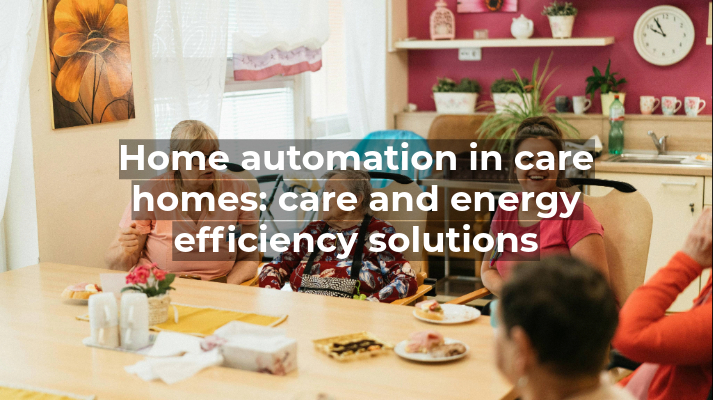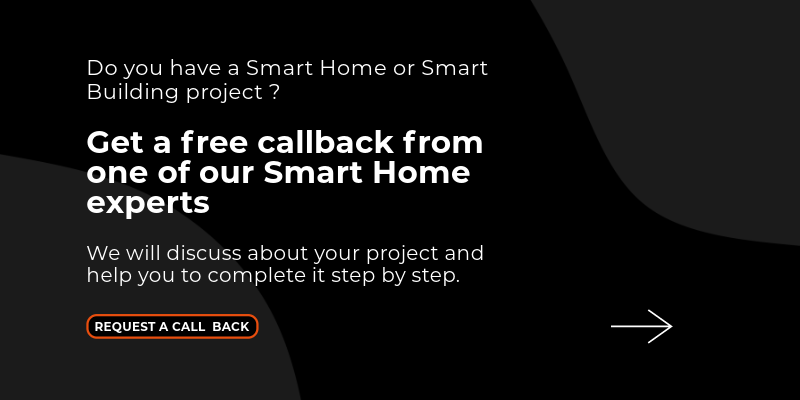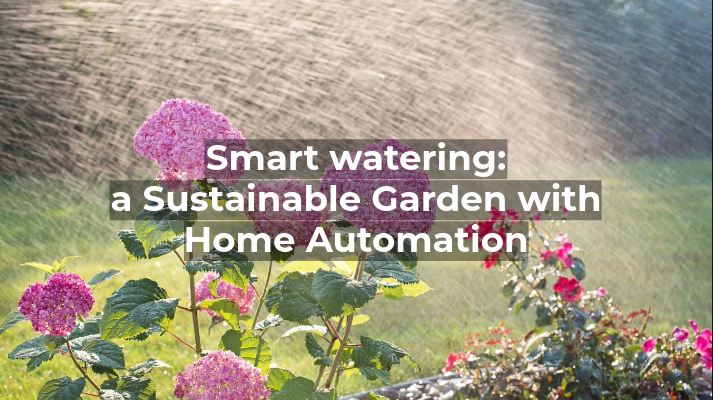In care homes, the adoption of home automation offers innovative solutions to support the elderly and disabled, improving the well-being and safety of residents, facilitating their care and optimising energy efficiency. Find out in detail which home automation solutions are particularly suitable for care homes!
The importance of home automation in care homes
Home automation in care homes makes it possible to improve the well-being of the elderly while ensuring safety and quality of life. Home automation solutions not only simplify the daily work of care staff, but also offer preventive solutions to improve safety at all times.
Home automation solutions for guest rooms and common areas
In the control room of the reception or in the various departments of a retirement home, the control panels of the home automation system are installed. Using these touch screens, operators can supervise, customise, activate or deactivate automations centrally and according to the type of guest within individual rooms or by zones. Thus, it is possible to manage, for example, lighting and heating or cooling in individual rooms as well as in communal areas based on the actual occupancy.
The home automation system can also detect alarms generated by telemedicine equipment and send notifications to the touch control panel or the staff’s mobile devices.
Now let’s look in detail at which home automation functions may be of particular interest for a care home:
1. Motion and presence sensors: These sensors detect the presence and movements of the residents in their rooms. For example, when a resident gets out of bed, the sensors automatically activate night lighting, reducing the risk of falls.
2. Emergency call and intercom buttons: Call buttons placed within easy reach allow guests to quickly contact staff. Some home automation systems also have intercoms for direct voice communication between residents and caregivers, making assistance operations quicker.
3. Smoke and gas detectors: Particularly useful for senior living communities with mini apartments, the sensors detect the presence of smoke or gas. If this happens, an alarm is immediately triggered (in the control room and on mobile devices) alerting staff. These systems can make the difference in preventing major incidents.
4. Intelligent lighting: Lighting systems can automatically activate upon detecting movement. This is especially useful for residents with visual or mobility impairments, facilitating safe movement.
5. Monitoring environmental parameters: To ensure a healthy environment, it is essential to monitor air quality and temperature. Automated ventilation and air conditioning systems maintain an optimal climate, adapting to external conditions and improving comfort for all residents.
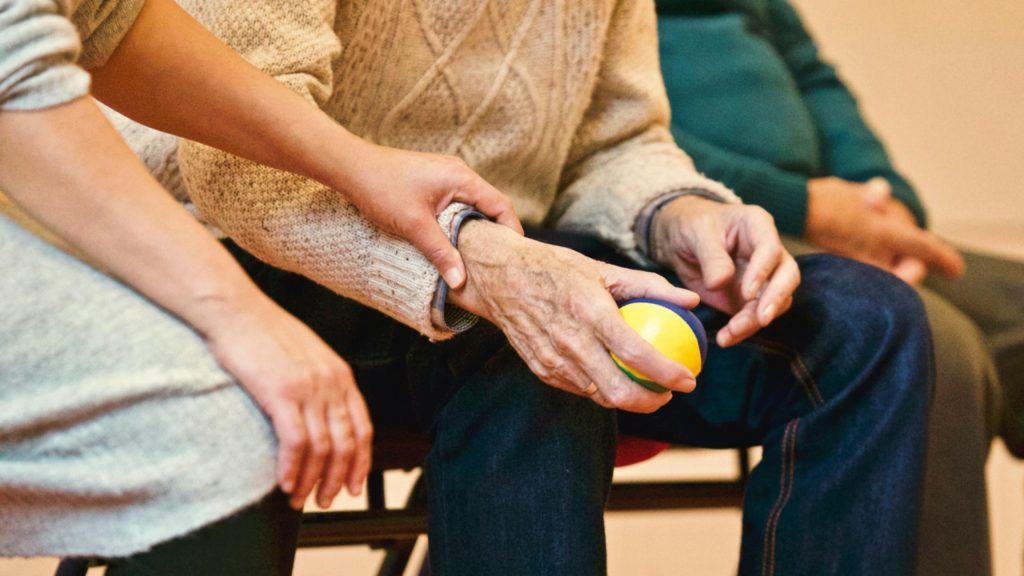
Prevention and timely reaction in case of accidents in retirement homes thanks to home automation
Home automation solutions in nursing homes, involving the integration of various sensors, are also able to detect alarms generated by telemedicine equipment, thus acquiring a crucial role in the prevention and management of incidents:
- Fall prevention: As described above, night lighting and motion sensors reduce the risk of falls when a resident gets out of bed during the night.
- Rapid reaction to critical events: Telemedicine equipment, such as alarms when a guest falls, can be integrated into a home automation system, where sensors send a notification to staff. These sensors are particularly useful in single rooms, where guests may not be able to call for help themselves.
- Prevention of domestic accidents: smoke, gas and water leakage detectors are essential for safety in care homes – both in the common areas and in mini apartments. If a critical event is detected, such as a gas leak, the system can activate automatic ventilation and send an alarm to evacuate the area.
Thanks to these solutions, care home automation in nursing homes allows proactive management of the safety and well-being of residents, offering them not only practical support, but also a safer environment that respects their needs and is more comfortable at all times of day.
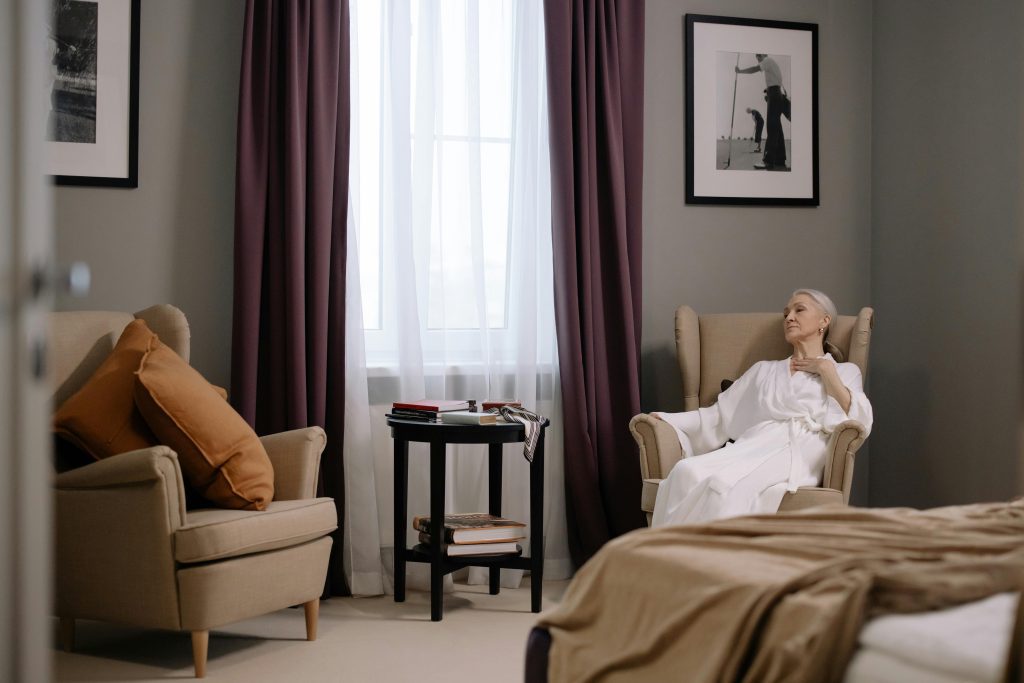
BACS and energy optimisation in residential care homes
Building Automation and Control Systems (BACS), the set of automation and intelligent regulation tools designed to reduce energy consumption, play a fundamental role in care homes. A home automation system such as the one proposed by Dovit allows real-time monitoring of water, gas and electricity consumption. Thanks to this continuous monitoring, it is possible to identify the moments of highest consumption and detect any waste, allowing a more precise and responsible management of energy resources.
Data analysis for an efficient energy management
A nursing home can have significant energy costs. The analysis of consumption flows in real time offers significant advantages for cost optimisation and building sustainability. With Do.Energy, Dovit offers a range of products dedicated to energy control, consumption analysis and the realisation of energy saving logics. Thanks to the data collected by BACS systems, it is possible to:
1. Identifying and reducing energy waste: A thorough analysis allows one to understand where the greatest dispersion occurs to take action and avoid waste.
2. Remote control: BACS systems allow care home staff to manage consumption remotely, adjusting lighting, heating/cooling and ventilation according to the actual presence of people in the various areas of the facility.
3. Reducing energy costs: Thanks to a more efficient use of resources, the operating costs of the residential care homes are significantly reduced, providing savings that can be reinvested to further improve the services offered to residents.
4. Maximising self-consumption: If the nursing home is equipped with photovoltaic panels, these can be connected to the home automation system, maximising self-consumption: for example, the use of particularly energy-hungry appliances could be programmed during peak power production hours, to make the most of surplus solar energy.
5. Increasing energy sustainability: The conscious use of energy resources not only reduces carbon emissions, but also contributes to making the entire facility more sustainable and in line with current energy and environmental regulations.
Success Stories : The Dovit solution installed in nursing homes
The Orchidée senior residence in Luxembourg
In the 42 flats of the Orchdée senior residence, the Dovit home automation system has been installed. The residents, via touch screen, can manage the lighting, shutters, temperature, access and security systems within their flats. Also via touch screen, they can access on-demand services such as cleaning, minor maintenance work or deliveries.
Ater’s smart flats in Mestre, Italy
In 2019, 37 smart flats managed by Ater, a housing company, were completed in the Mestre district of Altobello (near Venice, Italy). The apartments are intended for frail people, in terms of age and low socioeconomic status. The flats are equipped with high technology and an innovative family assistance programme: one flat hosts condominium carers, operators chosen by the social services of the Venice City Council who take turns in assisting residents, day and night.
What home automation features has Dovit provided to nursing homes?
- Room temperature control for each room
We have incorporated a probe that communicates with our DOVIT system and makes it possible to control the temperature in the building. At the same time, guests are not given the opportunity to change the setpoint to avoid unnecessary temperature changes that may cause energy waste. The temperature control of all rooms is managed by the operators from a touch screen.
- Security and alarmss
For the safety of the guests, we have developed an alarm display system for the operators: by being able to display alarms such as alarm bells in the bathrooms or the classic ringing in the corridor on a touch screen at a control point, the operator can intervene promptly.
- Reducing energy consumption
To reduce energy consumption, we have put the home automation system and the heating plant in communication. The system is therefore able to detect how many rooms are requiring ‘heat’ so that the central heating plant works according to the energy needed.
- Consumption analysis and lower energy bills
For a complete consumption analysis, we have installed network analysers that record consumption data over time. Using a specially designed platform (Do-EnergyLog), facility administrators can visualise and analyse energy consumption. This allows them to understand where waste occurs and to avoid it to lower energy expenses.
Work in progress: 3 renovations of care homes with Dovit
Currently, in cooperation with our partners, three nursing homes in Piedmont are being renovated. For all three projects, for which Dovit is providing the domotic solutions, the builder is Sviluppo Verde, the integrator GBS, and Max Service is providing the installation.
1. Care home “Casa amica” (Turin, Italy)
2. Home for Elderly “Casa dell’anziano” (Pinerolo, Turin, Italy)
3. Care home “Giacomo Bernardi” (Pinerolo, Turin, Italy)
Conclusion
An integrated home automation system in care homes becomes a strategic tool to improve the well-being of the residents, the operational efficiency of the staff and the environmental impact of the building, ensuring a comfortable and safe environment. Dovit can provide a complete home automation system for care homes, including BACS for energy saving – contact us for all information you need
